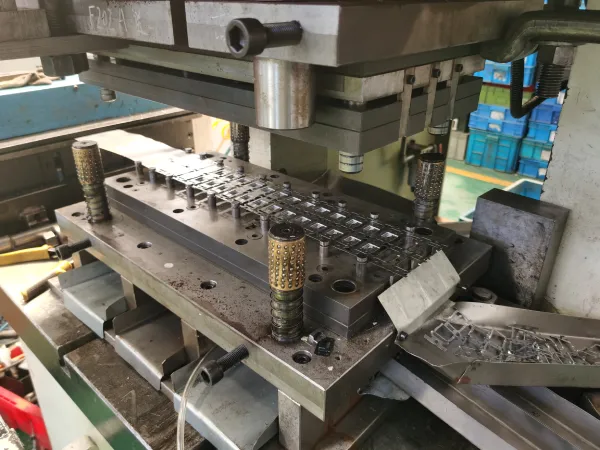Metal Stamping Procedures: From Prototyping to Mass Production
Wiki Article
Advanced Techniques in Metal Stamping for Accuracy Production
As markets consistently demand better tolerances and elaborate styles in their steel parts, the pursuit for advanced techniques in steel marking has actually heightened. From the use of sophisticated multi-stage stamping processes to the assimilation of cutting-edge automation technologies, the landscape of metal stamping is undertaking a profound improvement.Advanced Multi-Stage Stamping Procedures
Discussing the complexities of sophisticated multi-stage stamping procedures discloses the innovative techniques utilized in contemporary manufacturing techniques. Metal Stamping. Multi-stage stamping is a complicated process that involves multiple steps to transform a flat sheet of metal into a last stamped product. Making use of progressive dies, where different operations are performed at each phase of the marking procedure, permits high accuracy and performance in the production of complex metal componentsDuring the initial stages of multi-stage stamping, the level steel sheet is fed right into the stamping press, where a series of dies are made use of to reduce and form the product. Succeeding phases entail extra developing, bending, and punching operations to additional improve the component. Each phase is very carefully created to build on the previous one, causing the development of complicated geometries with tight resistances.
Advanced multi-stage marking processes require a high level of know-how and precision to ensure the quality and uniformity of the stamped parts. By making use of innovative machinery and tooling, manufacturers can generate a vast array of metal elements with effectiveness and precision.
Accuracy Tooling Innovations
Precision tooling advancements have reinvented the metal marking market, boosting efficiency and quality in producing processes. CNC systems enable for detailed designs to be equated straight right into tooling, guaranteeing precision and repeatability in the stamping procedure.Additionally, the assimilation of sensing units and real-time tracking capacities in accuracy tooling has actually allowed makers to identify and deal with problems without delay, reducing downtime and minimizing scrap prices. By incorporating clever innovation right into tooling, operators can optimize specifications such as pressure, rate, and positioning during the marking procedure, leading to improved item top quality and increased productivity.

Automation in Steel Stamping
The development of accuracy tooling advancements in the metal stamping industry has led the way for substantial improvements in automation, transforming the manufacturing landscape in the direction of raised performance and efficiency. Metal Stamping. Automation in metal stamping entails making use of sophisticated machinery and robotics to perform numerous tasks typically executed by human operators. This change towards automation uses countless benefits, including improved precision, much faster manufacturing cycles, and decreased labor costsOne trick element of automation in steel marking is the application of computer mathematical control (CNC) systems, which allow precise control over the marking process. CNC modern technology permits the creation of facility and complex metal get rid of consistent quality. Additionally, automated systems can be configured to run continuously, bring about higher result rates and shorter preparations.
Additionally, automation enhances office safety by lowering manual handling of hefty products and reducing the danger of accidents (Metal Stamping). As making industries remain to accept automation, the future of steel stamping holds excellent promise for also better efficiency and advancement
High-Speed Stamping Techniques

Among the primary advantages of high-speed stamping techniques is the ability to create a big volume of parts in a shorter amount of time compared to conventional marking approaches. This boosted performance not just permits producers to satisfy limited useful source manufacturing target dates yet additionally makes it possible for cost savings with economic climates of scale. Furthermore, high-speed stamping can help in reducing material waste by enhancing the product usage during the marking procedure.
Additionally, high-speed marking strategies typically include cutting-edge attributes such as fast die change systems and real-time surveillance abilities, even more enhancing the overall performance and flexibility of the metal marking procedure. As innovation remains to advance, high-speed marking is expected to play a vital function in driving the future of precision production.
Quality Assurance in Stamping Workflow
Reliable high quality control steps are important for guaranteeing the integrity and uniformity of metal marking operations. Quality assurance in stamping procedures entails a collection of systematic procedures aimed at detecting and protecting against issues in the made components. One i was reading this critical element of quality assurance in steel marking is making use of sophisticated examination methods such as optical inspection systems and coordinate determining equipments (CMMs) to confirm the measurements and tolerances of stamped components.Additionally, high quality control measures imp source in stamping procedures frequently consist of the implementation of analytical procedure control (copyright) methods to keep an eye on the manufacturing process in real-time and make sure that it continues to be within appropriate limitations. By assessing data and determining fads, makers can proactively address any type of variances from the wanted quality standards.
Moreover, top quality control in metal stamping procedures likewise involves complete product screening to ensure that the raw materials made use of satisfy the needed specifications for the marking procedure. This might include conducting material hardness examinations, tensile toughness tests, and dimensional assessments to assure the top quality and honesty of the stamped components. Overall, executing robust quality assurance procedures is critical for attaining high-quality stamped parts consistently.
Conclusion
To conclude, progressed strategies in steel marking play a critical duty in accuracy production processes. Through multi-stage stamping procedures, cutting-edge tooling remedies, automation, high-speed methods, and extensive high quality control measures, manufacturers can achieve greater degrees of accuracy and efficiency in their procedures. These improvements in metal stamping technology have actually made it possible for business to create intricate get rid of tight resistances, inevitably leading to improved item quality and client contentment in the manufacturing industry.Report this wiki page